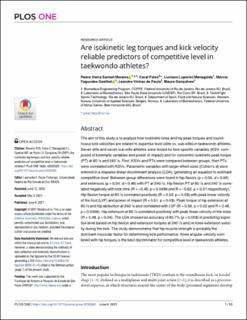| dc.contributor.author | Moreira, Pedro Vieira Sarmet | |
| dc.contributor.author | Falco, Coral | |
| dc.contributor.author | Menegaldo, Luciano Luporini | |
| dc.contributor.author | Goethel, Márcio Fagundes | |
| dc.contributor.author | de Paula, Leandro Vinhas | |
| dc.contributor.author | Goncąlves, Mauro | |
| dc.date.accessioned | 2021-08-24T06:54:45Z | |
| dc.date.available | 2021-08-24T06:54:45Z | |
| dc.date.created | 2021-07-07T14:09:50Z | |
| dc.date.issued | 2021 | |
| dc.identifier.citation | Moreira, P. V. S., Falco, C., Menegaldo, L. L., Goethel, M. F., de Paula, L. V., & Gonçalves, M. (2021). Are isokinetic leg torques and kick velocity reliable predictors of competitive level in taekwondo athletes? Plos One, 16(6). | en_US |
| dc.identifier.issn | 1932-6203 | |
| dc.identifier.uri | https://hdl.handle.net/11250/2770846 | |
| dc.description.abstract | The aim of this study is to analyze how isokinetic knee and hip peak torques and roundhouse kick velocities are related to expertise level (elite vs. sub-elite) in taekwondo athletes. Seven elite and seven sub-elite athletes were tested for kick-specific variables (KSV, composed of kinematic variables and power of impact) and for concentric isokinetic peak torque (PT) at 60°/s and 240°/s. First, KSVs and PTs were compared between groups, then PTs were correlated with KSVs. Parametric variables with larger effect sizes (Cohen’s d) were entered in a stepwise linear discriminant analysis (LDA), generating an equation to estimate competitive level. Between-group differences were found in hip flexors (p = 0.04, d = 0.92) and extensors (p = 0.04, d = 0.96) with PT at 240°/s. Hip flexion PT at 60°/s and 240°/s correlated negatively with kick time (R = –0.46, p = 0.0499 and R = –0.62, p = 0.01 respectively). Hip flexion torque at 60°/s correlated positively (R = 0.52, p = 0.03) with peak linear velocity of the foot (LVF) and power of impact (R = 0.51, p = 0.03). Peak torque of hip extension at 60°/s and hip abduction at 240°/s also correlated with LVF (R = 0.56, p = 0.02 and R = 0.46, p = 0.0499). Hip extension at 60°/s correlated positively with peak linear velocity of the knee (R = 0.48, p = 0.04). The LDA showed an accuracy of 85.7% (p = 0.003) in predicting expertise level based on hip flexion and extension torques at 240°/s and on knee extension velocity during the kick. The study demonstrates that hip muscle strength is probably the dominant muscular factor for determining kick performance. Knee angular velocity combined with hip torques is the best discriminator for competitive level in taekwondo athletes. | en_US |
| dc.language.iso | eng | en_US |
| dc.publisher | PLOS | en_US |
| dc.rights | Navngivelse 4.0 Internasjonal | * |
| dc.rights.uri | http://creativecommons.org/licenses/by/4.0/deed.no | * |
| dc.subject | hip | en_US |
| dc.subject | knees | en_US |
| dc.subject | torque | en_US |
| dc.subject | kinematics | en_US |
| dc.subject | musculoskeletal mechanics | en_US |
| dc.subject | skeletal joints | en_US |
| dc.subject | human performance | en_US |
| dc.subject | sports | en_US |
| dc.title | Are isokinetic leg torques and kick velocity reliable predictors of competitive level in taekwondo athletes? | en_US |
| dc.type | Peer reviewed | en_US |
| dc.type | Journal article | en_US |
| dc.description.version | publishedVersion | en_US |
| dc.rights.holder | © 2021 Moreira et al. | en_US |
| dc.source.pagenumber | 0 | en_US |
| dc.source.volume | 16 | en_US |
| dc.source.journal | PLOS ONE | en_US |
| dc.source.issue | 6 | en_US |
| dc.identifier.doi | 10.1371/journal.pone.0235582 | |
| dc.identifier.cristin | 1920735 | |
| cristin.ispublished | true | |
| cristin.fulltext | original | |
| cristin.qualitycode | 1 | |

